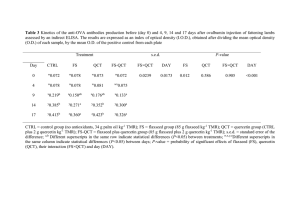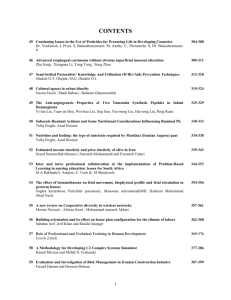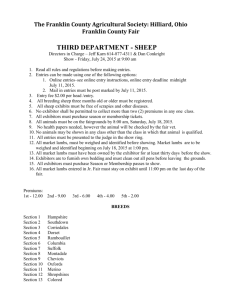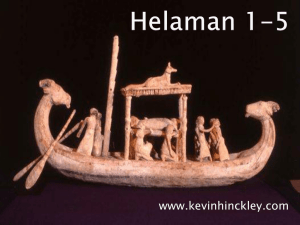Artículo 3 - digital
advertisement
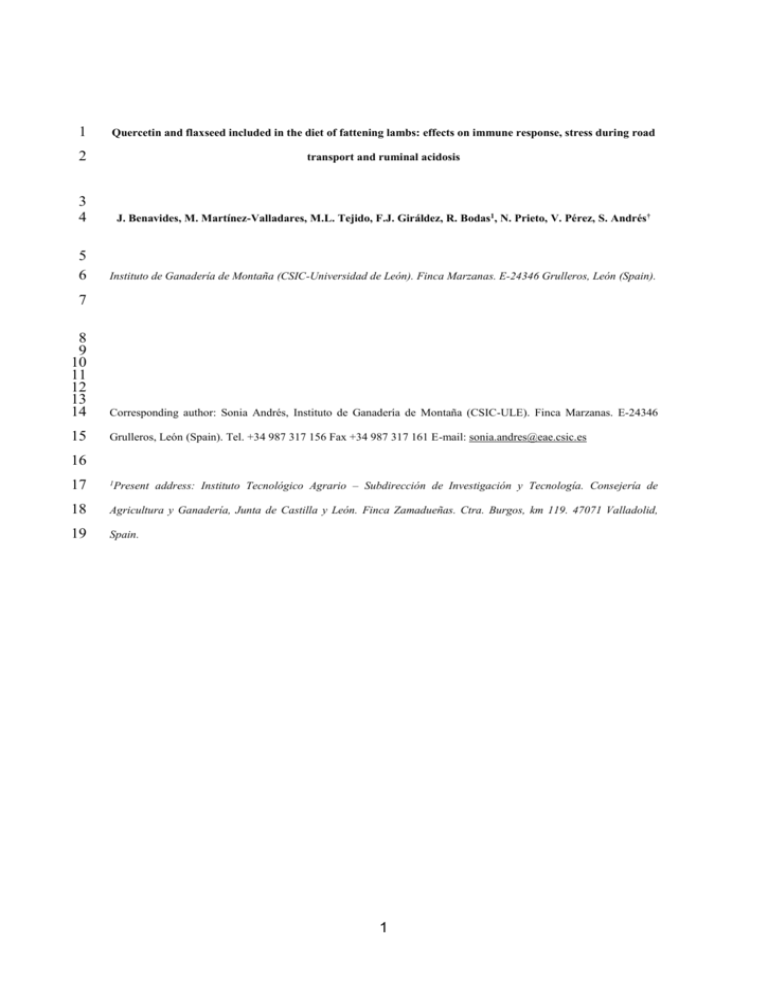
1 Quercetin and flaxseed included in the diet of fattening lambs: effects on immune response, stress during road 2 transport and ruminal acidosis 3 4 J. Benavides, M. Martínez-Valladares, M.L. Tejido, F.J. Giráldez, R. Bodas1, N. Prieto, V. Pérez, S. Andrés† 5 6 Instituto de Ganadería de Montaña (CSIC-Universidad de León). Finca Marzanas. E-24346 Grulleros, León (Spain). 7 8 9 10 11 12 13 14 Corresponding author: Sonia Andrés, Instituto de Ganadería de Montaña (CSIC-ULE). Finca Marzanas. E-24346 15 Grulleros, León (Spain). Tel. +34 987 317 156 Fax +34 987 317 161 E-mail: sonia.andres@eae.csic.es 16 17 1Present 18 Agricultura y Ganadería, Junta de Castilla y León. Finca Zamadueñas. Ctra. Burgos, km 119. 47071 Valladolid, 19 Spain. address: Instituto Tecnológico Agrario – Subdirección de Investigación y Tecnología. Consejería de 1 20 Abstract 21 Thirty two lambs were divided in 4 groups with 2 replicates each (8 batches in total) according to their body weights. 22 The lambs were fed a total mixed ration (TMR) formulated either with palm oil (CTRL; 2 replicates, 4 animals per 23 replicate; 34 g palm oil kg-1 TMR) or flaxseed (FS, 2 replicates, 4 animals per replicate; 85 g flaxseed kg-1 TMR). 24 Four more batches were fed the same TMRs but enriched with quercetin (QCT, 2 replicates, 4 animals per replicate, 25 34 g palm oil plus 2 g quercetin kg-1 TMR; FS-QCT, 2 replicates, 4 animals per replicate, 85 g flaxseed plus 2 g 26 quercetin kg-1 TMR). Three weeks after starting with the experimental diets, the animals were immunised by a 27 subcutaneous injection of ovalbumin, and blood samples were collected at days 0, 4, 9, 14 and 17 post-immunization 28 to measure antibodies against ovalbumin. Afterwards, all of the lambs were subjected to a 4-h transportation-stress 29 period to study the evolution of haematological and biochemical parameters during road transport and, finally, 30 slaughtered. Mean Ova-specific IgG titres were significantly lower in the lambs fed FS on days 14 and 17 when 31 compared to CTRL group (FS×DAY, P=0.033). Additionally, FS reduced white blood cells counts and tissue damage 32 (creatine phosphokinase, P<0.05) during road transport. Consequently, flaxseed showed some immunological 33 properties and protection against tissue damage during road transport. Regarding ruminal acidosis, both quercetin and 34 flaxseed seemed to be adequate to reduce the level of parakeratosis. 35 Keywords: immune response, acidosis and oxidative stress, quercetin, flaxseed, lamb 36 Introduction 37 Several studies performed during the last two decades have evidenced a strong relationship between nutrition and 38 immune response (Carroll and Forsberg, 2007). Lately, some substances such as polyunsaturated fatty acids (PUFAs) 39 or phenolic compounds which are being included in the diet of animals in order to improve meat or milk quality 40 attributes also have demonstrated immunomodulator properties. 41 Most of these studies have been performed in vitro or in small monogastrics such as rodents or rabbits (Wallace 42 et al., 2001; Arita et al., 2005). However, in spite of its relevance, there is a lack of experiments which have been 43 focused on the effects of nutrition on the immune response in livestock animals. Moreover, the few studies which can 44 be found in the literature have described different or contradictory effects attending to physiological, nutritional or 45 environmental conditions. For example, n−3 PUFAs in fish oil seem to be related to a lower lymphocyte proliferation 46 (anti-inflammatory effect) in periparturient cows (Lessard et al., 2003) whereas under high temperature conditions 47 n−3 PUFAs seem to promote a pro-inflammatory response (Caroprese et al., 2009). These contradictory results might 48 be explained by different antioxidant requirements promoted by stress conditions, since these PUFAs are more 49 sensitive to oxidative stress than saturated fats (Carroll and Forsberg, 2007). Additionally, it must be considered that 50 cells of the immune system are highly reactive. Consequently immune cells, which have a high percentage of PUFAs 51 in their plasma membranes, are dependent particularly on high levels of antioxidants to protect them from cell and 52 membrane damage promoted by reactive oxygen species (ROS) (Nockels, 1996). 2 53 Although the body produces a number of endogenous antioxidants as a defense mechanism against ROS, under 54 conditions of high oxidative stress (e.g., PUFAs rich diets, road transport, etc.) the ability to eliminate ROS can be 55 exceeded. Then, dietary sources of antioxidants can be beneficial in reducing the deleterious effects of ROS on the 56 highly reactive cells of the immune system (Carrol and Forsberg, 2007; Hamer, 2007). In this sense, plants provide a 57 potential source of phytochemicals with antioxidant and immunomodulatory properties such as phenolic compounds, 58 so the interest in these substances has increased in the last decade in human and animal medicine, as they are 59 perceived by the consumer as a natural approach to treat diseases and preserve food safety. In this sense quercetin is a 60 flavonoid with demonstrated antioxidant, antiviral and anticarcinogenic properties in monogastrics (Nair et al., 2002). 61 However, there is little information about the effectiveness of this compound when included in the diet of ruminants. 62 The objective of this study was to test, on the one hand, whether flaxseed (rich in PUFAs) and quercetin allow 63 modifying immune response (antibody, and haematological parameters) in fattening lambs when included in the diet. 64 Also, changes related to ruminal/metabolic acidosis and the fatigue of animals when stressed by road transport were 65 measured. 66 Material and Methods 67 Animals and diets 68 Two weeks before the commencement of the trial, 32 male Merino lambs were treated with Ivermectin (Ivomec, 69 Merial Labs, Barcelona, Spain) and vaccinated against enterotoxaemia (Miloxan, Merial Labs, Barcelona, Spain). 70 After stratification on the basis of body weight (average body weight (BW), 15.5 ± 2.12 kg), the lambs were 71 allocated randomly to 4 different groups (2 replicates per dietary treatment, 8 batches in total). All of the groups were 72 fed their corresponding total mixed ration (TMR) as described below: two replicates of the control group (CTRL, 4 73 animals per replicate; 34 g palm oil kg-1 TMR), two replicates fed ground flaxseed (FS, 4 animals per replicate; 85 g 74 flaxseed kg-1 of TMR), two replicates fed control diet plus quercetin (Shaanxi Sciphar Biotechnology Co., Ltd, Xi'an, 75 China) (QCT, 4 animals per replicate; 34 g palm oil plus 2 g quercetin kg-1 TMR), and two replicates fed ground 76 flaxseed plus quercetin (FS-QCT, 4 animals per replicate; 85 g flaxseed plus 2 g quercetin kg-1 TMR). The four 77 TMRs were formulated to be isoenergetic and isoproteic. The ingredients and chemical composition of TMR are 78 shown in Table 1. All handling practises followed the recommendations of the European Council Directive 79 86/609/EEC for the protection of animals used for experimental and other scientific purposes and all the animals were 80 able to see and hear other animals. 81 [INSERT TABLE 1 NEAR HERE, PLEASE] 82 After 7 days of adaptation to the basal diet, all of the lambs were fed the corresponding TMR (CTRL, FS, QCT 83 and FS-QCT groups) ad libitum during the experimental period (at least 5 weeks, until the animals reached the 84 intended BW, approx. 25 kg). The TMR was weighed and supplied ad libitum at 9:00 a.m. every day, and fresh 3 85 drinking water was always available. Samples of feed offered and orts (approximately 20% of total offered) were 86 taken daily, pooled to an individual composite sample every week, oven-dried at 55°C for at least 72 h (to constant 87 weight), ground to pass through a 1-mm screen using a Willey mill (Arthur H. Thomas, Philadelphia, PA), and stored 88 until analyses. Only one computation of DM intake, average daily gain and feed conversion ratio was computed for 89 each batch of animals. 90 OVA immunization and anti-OVA ELISA 91 Three weeks after beginning the test, the animals were immunised by a subcutaneous injection of 1 mg chicken egg 92 albumin (day 0; ovalbumin, OVA) (Sigma, Madrid, Spain) emulsified in Montanide ISA 206 VF (Seppic, Paris, 93 France) at 1 mg/ml. 94 For the detection of the antibodies against OVA, slightly modified methods explained in Wattegedera et al. 95 (2008) were followed. Briefly, high affinity-binding 96-well flat-bottom ELISA plates (Thermo Fisher Scientific, 96 Madrid, Spain) were coated overnight at 4 °C with 1 μg/ml OVA diluted in carbonate-bicarbonate buffer. As a 97 positive control, and in order to standardize the absorbance obtained in the different plates, 100 μl of a 1:1000 98 dilution of a monoclonal anti-chicken egg albumin (Clone OVA-14, Sigma, Madrid, Spain) was used in all the plates. 99 Aliquots from the same serum obtained from a non-immunised sheep diluted 1:100 were used as a negative control in 100 all the plates. Plates were incubated with 100 μl test sera, diluted 1:100, in duplicate; horseradish peroxidase 101 conjugate protein G (BioRad Laboratories, Richmond, Ca, USA) at 1:1500 dilution was added as secondary Ab and 102 ABTS, 2,2'-azino-di-3-ethylbenzthiazoline sulfonic acid (Boheringer Mannheim GmbH, Mannheim, Germany) was 103 added to each well as enzymatic substrate. The absorbance values were measured spectrophotometrically using an 104 ELX800 ELISA reader (Bio-Tek Instruments, Winooski, USA) at 450 nm. Results were expressed as a quotient of 105 the mean optical density (O.D.) of each serum and the mean O.D. of the positive control sample in each plate. 106 Blood samples were collected at days 0, 4, 9, 14 and 17 post-immunization by jugular venipuncture into non- 107 heparinised vacutainers (Becton Dickinson, Madrid, Spain). They were allowed to clot and the serum was stored at 108 −20 °C until used for serological analyses. 109 Stress induction 110 Road transportation was used as a quantifiable source of stress (Averós et al., 2009). After having collected the last 111 blood sample for anti-ova ELISA analysis (day 17 after ovalbumin injection, that is to say 5 weeks after having 112 started with the experimental diets), all of the animals were subjected to a 4 h-transportation period, at a space 113 allowance of 0.30 m2 per animal in a truck with a non-slip metal floor that was covered with straw bedding. Before 114 the road transport (PRE) and immediately after the 4 h-transportation period (POST) blood samples were collected 115 by jugular venipuncture into two 10 ml vacutainers containing either no anticoagulant or EDTA. Biochemical 4 116 (cortisol, glucose, creatine phosphokinase (CPK), lactate, and lactate dehydrogenase (LDH)) and haematological 117 analyses were performed as explained by López-Campos et al. (2010). 118 Rumen and liver sampling 119 Finally, all of the lambs were weighed (24.8 ± 1.05 kg), stunned, slaughtered by exsanguinations from the jugular 120 vein, eviscerated and skinned. Liver was weighed and a piece of liver was cut and kept at -80 ºC until thiobarbituric 121 acid reactive substances (TBARS) analysis (Bodas et al., 2012). Rumen was weighed emptied, rumen fluid was 122 strained through 4 layers of cheesecloth and pH was determined immediately. Then, two square samples of 3×2 cm 123 from different locations of ruminal wall (posterior dorsal and anterior ventral areas) were placed into histological 124 cassettes, washed under tap water and then fixed by immersion in 10% buffered formalin for one week. Digital gross 125 pictures of the ruminal mucosa were taken to measure the colour of the ruminal epithelium as an indicator of the 126 degree of keratinisation. Pictures from all the samples (image size 6mp) were taken with the same camera (Lens: 127 Nikkor 105 mm f/2.8 D AF Micro. Camera: Nikon D100; Nikon Europe BV, Badhoevedorp, The Netherlands), 128 where focus, lens aperture and exposure time were set to manual, adjusted at the first sample and then kept 129 unchanged until all the pictures were taken. During the whole process, the camera was attached to a stand with 130 incandescent bulbs for illumination; the position of the camera and the bulbs remained unchanged for all the pictures. 131 There was a scale on a known size in all the pictures so measurements could be carried out. 132 Once downloaded into the computer, a 1×1 cm representative area of the region of interest located over a 133 representative area of each sample of ruminal epithelium was selected and the ruminal papillae within this area were 134 counted. The picture was then converted to grey values and the mean grey value (ranging from 0 to 255, where 0 is 135 black and 255 is white) of the selected region of interest was measured. A mean value was obtained for the two areas 136 studied from each rumen. All these operations were performed with the ImageJ 1.43 software (Rasband, W.S., 137 ImageJ, U. S. National Institutes of Health, Bethesda, Maryland, USA). 138 Statistical analyses 139 Individual animal data of rumen (including number of papillae and colour) and liver characteristics, and batch data of 140 dry matter intake (DMI), average daily gain (ADG) and feed to gain ratio (FC), were subjected to a two way analysis 141 of variance, using the GLM procedure of SAS (SAS Inst. Inc.) according to the following model: 142 yijk = μ + FSi + QCTj + (FS×QCT)ij + εijk 143 where yijk is the dependent variable, μ is the overall mean, FS is the effect of flaxseed addition, QCT is the effect 144 of quercetin addition, FS×QCT is the effect of the interaction between quercetin and flaxseed, and ε ijk is the residual 145 error. Least square means were generated and separated using the PDIFF option of SAS for main or interactive 146 effects, with the level of significance being determined at P<0.05. 5 147 Data of antibody production and the evolution of biochemical parameters and white blood cells during road 148 transport were analysed as a repeated measures design using the MIXED procedure of SAS (SAS Inst. Inc.), with 149 flaxseed and quercetin addition and day as fixed effects and animal within treatment as the experimental unit, 150 according to the following model: 151 yijklm = μ + FSi + QCTj + (FS×QCT)ij + TIMEk + FS×TIMEik + QCT×TIMEjk + FS×QCT×TIMEijk + 152 ANIMAL(FS×QCT)ijl + εijklm 153 where yijklm is the dependent variable, μ is the overall mean, FS is the effect of flaxseed, QCT is the effect of 154 quercetin addition, TIME is the effect of the time (sampling day or hour), ANIMAL(FS×QCT) the animal within 155 treatments as the experimental unit and εijklm is the residual error. Different covariance matrixes were evaluated on the 156 basis of Schwarz´s Bayesian information model fit criteria. Least square means were generated and separated using 157 the PDIFF option of SAS for main or interactive effects, with the level of significance being determined at P<0.05. 158 For reasons of clarity reasons, tables only show the diet interaction; diet by day interactions are mentioned in the text 159 when they were or tended to be statistically significant (P<0.05 or P<0.10, respectively). 160 Results 161 Intake, average daily gain and feed-to-gain ratio 162 Table 2 summarizes the production parameters of the lambs. There were no differences between the groups in terms 163 of TMR intake. However, a trend toward significantly higher values (P=0.077) in the ADG was observed for the 164 lambs being fed flaxseed (FS and FS-QCT groups). 165 [INSERT TABLE 2 NEAR HERE, PLEASE] 166 Anti-OVA antibody response 167 Anti-Ova IgG was detectable in the sera of all lambs from day 9 post immunisation until the end of the experiment 168 with values increasing with time (Table 3). Mean Ova-specific IgG titres, measured as a quotient, in the flaxseed- 169 supplemented groups (FS and FS-QCR) tended to be lower at day 9 post immunization and were significantly lower 170 (FS×DAY, P=0.033) on days 14 and 17 when compared to CTRL group. 171 [INSERT TABLE 3 NEAR HERE, PLEASE] 172 Evolution of haematological and biochemical parameters during road transport 173 As expected, no effect of the diet on cortisol or glucose levels was observed before (PRE) or after (POST) road 174 transport (data not shown). However, a significant effect of flaxseed (P=0.027) was observed, animals being fed 175 flaxseed (FS and FS-QCT groups) presenting lower levels of CPK in blood before (PRE, 186 and 222 U/L, 176 respectively) or after road transport (POST, 218 and 224 U/L, respectively) when compared to the CTRL and QCT 177 lambs (PRE, 216 and 234 U/L, respectively; POST, 253 and 284 U/L, respectively). The rest of parameters [LDH or 6 178 lactate], which are indicators of tissue damage during road transport (Jiang and Ames, 2003), showed no differences 179 among groups (data not shown). 180 Table 4 summarizes the changes in white blood cell (WBC) counts in the lambs as a consequence of road 181 transport. Before road transport (PRE) the lambs being fed flaxseed (FS and FS-QCT groups) presented lower levels 182 of total WBC counts when compared to CTRL and QCT groups, whereas quercetin did not seem to have an effect on 183 this parameter. After road transport (POST) a significant decrease in total WBC counts was detected in all of the 184 groups (P<0.001); however, the lowest levels still occurred in the FS and FS-QCT groups. Regarding the differential 185 counts of WBCs, lymphocytes were lower in the lambs being fed flaxseed (FS and FS-QCT groups) before (PRE) 186 and after road transport (POST), whereas granulocytes and monocytes counts did not seem to be affected either by 187 dietary flaxseed or quercetin. 188 [INSERT TABLE 4 NEAR HERE, PLEASE] 189 Rumen and liver characteristics 190 Table 5 summarizes the results regarding ruminal and liver characteristics obtained after slaughter. All of the groups 191 presented similar ruminal pH values, with no significant differences being observed among them (P>0.05). However, 192 the lambs from the CTRL group showed a darker ruminal epithelium and a heavier empty rumen weight when 193 compared to the animals from the other groups (P<0.05). There were no differences in the number of papillae 194 between the different groups (mean value of all the animals, 88.5±3.51 papillae/cm2). A trend towards significantly 195 higher liver weights was observed in the animals being fed quercetin (QCT and FS-QCT lambs) when compared to 196 the CTRL and FS groups (P=0.062), whereas the lambs being fed flaxseed (FS and FS-QCT) showed a trend towards 197 significantly lower levels in liver TBARS values (P=0.060). 198 [INSERT TABLE 5 NEAR HERE, PLEASE] 199 Discussion 200 Intake, average daily gain and feed-to-gain ratio 201 Although all of the animals were fed ad libitum, no significant differences were observed in feed intake, ADG or FC 202 (Table 2), as diets were isoenergetic and isoproteic. 203 Anti-OVA antibodies response 204 Quercetin had no effect on antibody production (QCT, P=0.586, Table 3), which is in agreement with the data 205 previously reported by other authors (Exon et al., 1998; Sforcin et al., 2005). Recently it has been demonstrated the 206 low bioavailability of quercetin aglycone in cows after intraruminal (or oral) application, unlike in monogastric 207 species (Berger et al., 2012), which might have been the cause of the lack of clear systemic effects in the present 208 study. 7 209 However, those animals supplemented with FS (FS and FS-QCT groups) showed lower anti-OVA antibodies titers 210 than CTRL and QCT groups (FS, P=0.012, Table 3). Supplementation of diets with n−3 fatty acids (such as those 211 provided by flaxseed) have been shown to decrease the inflammatory response (both serum antibodies and local 212 subcutaneous inflammation) of type I hypersensitivity reactions involving OVA sensitization in murine models 213 (Hogenkamp et al., 2011; de Matos et al., 2012). This might be due to the fact that the fatty acid composition of 214 lymphocytes and other immune cells is modified according to the fatty acid composition of the diet, which alters the 215 capacity of those cells to produce eicosanoids involved in immunoregulation (Calder, 2007). Omega-3 fatty acids 216 such as α-linolenic acid (C18:3n−3) are metabolized to eicosapentaenoic acid (EPA), which leads to an anti- 217 inflammatory environment, thus reducing serum antibodies through inhibition of the secretion of several pro- 218 inflammatory cytokines, such as IL-2 or TNF-α (Mullen et al., 2010; de Matos et al., 2012). 219 Stress induction 220 Biochemical parameters during road transport indicated that all of the groups were stressed similarly as a 221 consequence of this management practice (data not shown). Thus, no differences among diets on cortisol levels or 222 serum glucose concentration (which is related to the activity of glucocorticoides and catecholamines) were apparent 223 either before or after road transport. However, there was a significant lowering effect of flaxseed (P=0.027) on CPK 224 levels before and after road transport, which may be indicating either a lower level of tissue damage or physical 225 fatigue of FS and FS-QCT lambs (Kramer and Hoffmann, 1997). In this regard, it must be noted that flaxseed is 226 characterised by higher levels of vitamin E than the palm oil present in the CTRL group (Schwartz et al., 2008), so 227 this potent antioxidant might have exerted some protection against stress produced by road transport (Morán et al., 228 2012) thus preserving the welfare of the lambs. The tendency to lower TBARS values in liver observed in FS lambs 229 when compared to the rest of groups (Table 5) seems to confirm this theory. 230 The mechanism by which n−3 PUFA affected the total WBC counts was not investigated in the current study, 231 but the results obtained are in agreement with other in vitro and animal feeding studies suggesting that saturated fatty 232 acids have a limited effect on immune function, whereas feeding plants rich in n−3 fatty acids such as flaxseed shows 233 immunomodulator properties (Calder et al., 2002; Lessard et al., 2003). Thus, the decrease in WBC counts observed 234 in the FS and FS-QCT lambs before the stress (PRE) in the present study (Table 4) would be in agreement with the 235 inhibition of T lymphocyte proliferation by n−3 FA reported previously in rats fed diets containing large amounts of 236 linseed oil compared with rats fed diets rich in hydrogenated coconut oil (Marshall and Johnston, 1985). Additionally, 237 dietary n−3 PUFAs have shown to decrease phagocytosis and lymphocyte proliferation in broiler chickens (Al- 238 Khalifa et al., 2012), and influence the transendothelial migration of leukocytes and leukocyte trafficking in general 239 (Grimm et al., 2002). However, due to the inherent complexity of the immune response, further experiments should 240 clarify whether these changes in the haematological profile of the lambs represent improved adaptation to the stress 241 promoted by road transport. 8 242 Finally, the descent in WBC counts (total, lymphocytes and granulocytes) observed in all of the groups after 243 road transport (POST) would be in agreement with physiological changes (neutrophilia and lymphopenia) observed 244 in stressed animals (Kannan et al., 2000). 245 Ruminal/metabolic acidosis 246 The partial substitution of cereal grains by dietary fat (palm oil or flaxseed) and the TMR (concentrate plus 15% 247 chopped barley straw, Table 1) fed to the fattening lambs might have reduced the incidence of ruminal acidosis and 248 the development of metabolic acidosis in the present study (DeVries and von Keyserlingk, 2009; González et al., 249 2012; Jenkins, 1993). This is in agreement with the lack of significant differences in the ruminal pH values (Table 5), 250 all the lambs having normal physiological values for this parameter. However, in the CTRL group the ruminal 251 mucosa was significantly darker, corresponding to brown colour appreciated at slaughter, which is an indirect 252 indicator for ruminal parakeratosis related with an increased thickness of the stratum corneum of the ruminal 253 epithelium (Alvarez-Rodriguez et al., 2012). This effect also might explain the increase in the weight of the empty 254 rumen (Table 5). This stratum has a protective function, and the number of cell layers present in it could be increased 255 as a consequence of several situations such as low ruminal pH, increased propionate:acetate ratios, and increased 256 molar proportions of butyrate and propionate (Baldwin, 1998). Since the composition, and specifically the 257 carbohydrate content, of the four diets was very similar and none of the groups developed ruminal acidosis, we are 258 uncertain about the cause of the darker colours in the CTRL group. Nevertheless, it must be borne in mind that either 259 only one measure or the average pH over a day is sometimes considered a poor indicator of ruminal acidosis (Sauvant 260 et al., 1999) because it does not reflect the large daily fluctuations in pH (Dragomir et al., 2008). However, our results 261 suggest that both additives, quercetin and flaxseed, somehow protected the ruminal mucosa against the development 262 of parakeratosis. Regardless of the mechanism of this protection, it is important to highlight this result, as 263 parakeratosis could be indicative of subacute ruminal acidosis, a condition caused by transient falls of ruminal pH to 264 ranges below pH 5.5, and with several negative consequences to the animal such as loss of condition, interference 265 with normal rumen microbiota or predisposition to septicaemia and abscesses formation in the liver (Kleen et al., 266 2003; Steele et al., 2009). 267 Conclusions 268 Flaxseed supplemented to fattening lambs exhibited some immunomodulator properties, although the biological 269 significance of these effects remains to be determined in further studies. Additionally flaxseed supplementation 270 tended to reduce the increments of a blood tissue damage indicator during road transport, thus preserving the health 271 of the animal under stress conditions. Moreover, parakeratosis in fattening lambs was reduced by both, quercetin and 272 flaxseed when included in the diet. Finally, it must be stated that the combination of both, quercetin and flaxseed in 273 the diet of fattening lambs does not seem to improve the benefits achieved with any of these ingredients when 274 included separately in the diet. 9 275 Acknowledgments 276 Financial support received from ‘Consejería de Educación de la Junta de Castilla y León’ (Project CSI185B11-2) is 277 gratefully acknowledged. Julio Benavides, María Martinez-Valladares, María L. Tejido, Raúl Bodas, and Nuria Prieto 278 (JAE-Doc contracts) were supported by the programme ‘Junta para la Ampliación de Estudios’ (CSIC-European 279 Social Fund). 280 References 281 Al-Khalifa, H., Givens, D.I., Rymer, C., Yaqoob, P., 2012. Effect of n−3 fatty acids on immune function in broiler 282 283 284 chickens. Poultry Sci. 91, 74-88. Alvarez-Rodríguez, J., Monleón, E., Sanz, A., Badiola, J.J., Joy, M., 2012. Rumen fermentation and histology in light lambs as affected by forage supply and lactation length. Res. Vet. Sci. 92, 247-53. 285 Arita, M., Yoshida, M., Hong, S., Tjonahen, E., Glickman, J.N., Petasis, N.A., Blumberg, R.S., Serhan, C.N., 2005. 286 Resolvin E1, an endogenous lipid mediator derived from omega-3 eicosapentaenoic acid, protects against 287 2,4,6-trinitrobenzene sulfonic acid-induced colitis. P. Natl. A. Sci. USA 102, 7671-7676. 288 Averós, X., Herranz, A., Sánchez, R., Gosálvez, L.F., 2009. Effect of the duration of commercial journeys between 289 rearing farms and growing–finishing farms on the physiological stress response of weaned piglets. Livest. Sci. 290 122, 339-344. 291 Baldwin, R.L., 1998. Use of isolated ruminal epithelial cells in the study of rumen metabolism. J. Nutr. 128, 293-296. 292 Berger, L.M., Wein, S., Blank, R., Metges, C.C., Wolffram, S., 2012. Bioavailability of the flavonol quercetin in 293 cows after intraruminal application of quercetin aglycone and rutin. J. Dairy Sci. 95, 5047–5055. 294 Bodas, R., Prieto, N., Jordan, M.J., López-Campos, Ó., Giráldez, F.J., Morán, L., Andrés, S., 2012. The liver 295 antioxidant status of fattening lambs is improved by naringin dietary supplementation at 0.15% rates but not 296 meat quality. Animal 6, 863-870. 297 Calder, P.C., 2007. Immunomodulation by omega-3 fatty acids. Prostag. Leukotr. Ess. 77, 327-35. 298 Calder, P.C., Yaqoob, P., Thies, F., Wallace, F.A., Miles, E.A., 2002. Fatty acids and lymphocyte functions. Brit. J. 299 300 301 302 303 Nutr. 87, 31-48. Caroprese, M., Marzano, A., Entrican, G., Wattegedera, S.A.M., Sevi, A., 2009. Immune response of cows fed polyunsaturated fatty acids under high ambient temperatures. J. Dairy Sci. 92, 2796-2803. Carroll, J.A., Forsberg, N.E., 2007. Influence of stress and nutrition on cattle immunity. Vet. Clin. N. Am.-Food A. 23, 105-49. 10 304 de Matos, O.G., Amaral, S.S., Pereira da Silva, P.E., Perez, D.A., Alvarenga, D.M., Ferreira, A.V., Alvarez-Leite, J., 305 Menezes, G.B., Cara, D.C., 2012. Dietary supplementation with omega-3-PUFA-rich fish oil reduces signs of 306 food allergy in ovalbumin-sensitized mice. Clin. Dev. Immunol. 2012:236564. 307 308 309 310 311 312 DeVries, T.J., von Keyserlingk, M.A.G., 2009. Short communication: feeding method affects the feeding behavior of growing dairy heifers. J. Dairy Sci. 92, 1161-1168. Dragomir, C., Sauvant, D., Peyraud, J.L., Giger-Reverdin, S., Michalet-Doreau, B., 2008. Meta-analysis of 0 to 8 h post-prandial evolution of ruminal pH. Animal 2, 1437-1448. Exon, J.H., Magnuson, B.A., South, E.H., Hendrix, K., 1998. Dietary quercetin, immune functions and colonic carcinogenesis in rats. Immunopharm. Immunot. 20, 173-190. 313 González, L.A., Manteca, X., Calsamiglia, S., Schwartzkopf-Genswein, K.S., Ferret, A., 2012. Ruminal acidosis in 314 feedlot cattle: Interplay between feed ingredients, rumen function and feeding behavior (a review). Anim. Feed 315 Sci. Technol. 172, 66-79. 316 317 318 319 Grimm, H., Mayre, K., Mayser, P., Eigenbrodt, E., 2002. Regulatory potential of n−3 fatty acids in immunological and inflammatory processes. Brit. J. Nutr. 87, 59-67. Hamer, M., 2007. The beneficial effects of tea on immune function and inflammation: a review of evidence from in vitro, animal and human research. Nutr. Res. 27, 373-379. 320 Hogenkamp, A., van Vlies, N., Fear, A.L., van Esch, B.C., Hoffman, G.A., Garssen, J., Calder, P.C., 2011. Dietary 321 fatty acids affect the immune system in male mice sensitized to ovalbumin or vaccinated with influenza. J. 322 Nutr. 141, 698-702. 323 Jenkins, T.C., 1993. Lipid metabolism in the rumen. J. Dairy Sci. 76, 3851-3863. 324 Jiang, Q., Ames, B.N., 2003. Gamma-tocopherol, but not alpha-tocopherol, decreases proinflammatory eicosanoids 325 326 327 and inflammation damage in rats. FASEB J., 17, 816-22. Kannan, G., Terrill, T.H., Kouakou, B., Gazal, O.S., Gelaye, S., Amoah, E.A., Samake, S., 2000. Transportation of goats: effects on physiological stress responses and live weight loss. J. Anim. Sci. 78, 1450-1457. 328 Kew, S., Banerjee, T., Minihane, A.M., Finnegan, Y.E., Williams, C.M., Calder, P.C., 2003. Relation between the 329 fatty acid composition of peripheral blood mononuclear cells and measures of immune cell function in healthy, 330 free-living subjects aged 25–72 yr. Am. J. Clin. Nutr. 77, 1278-1286. 331 332 Kleen, J.L., Hooijer, G.A., Rehage, J., Noordhuizen, J.P., 2003. Subacute ruminal acidosis (SARA): a review. J. Vet. Med. A Physiol. Pathol. Clin. Med. 50, 406-14. 11 333 334 335 336 Kramer, J.W., Hoffmann, W.E., 1997. Clinical enzymology, in: Kaneko, J.J., Harvey, J.W., Bruss, M.L. (Eds.), Clinical biochemistry of domestic animals. Academic Press, California, 303-325. Lessard, M., Gagnon, N., Petit, H.V., 2003. Immune response of postpartum dairy cows fed flaxseed. J. Dairy Sci. 86, 2647-57. 337 López-Campos, Ó., Bodas, R., Prieto, N., Giráldez, F.J., Pérez, V., Andrés, S., 2010. Naringin dietary 338 supplementation at 15% rates does not provide protection against sub-clinical acidosis and does not affect the 339 responses of fattening lambs to road transportation. Animal 4, 958-964. 340 341 Marshall, L.A., Johnston, P.V., 1985. The influence of dietary essential fatty acids on rat immunocompetent cell prostaglandin synthesis and mitogen-induced blastogenesis. J. Nutr. 115, 1572-1580. 342 Morán, L., Andrés, S., Bodas, R., Benavides, J., Prieto, N., Pérez, V., Giráldez, F.J., 2012. Antioxidants included in 343 the diet of fattening lambs: effects on immune response, stress, welfare and distal gut microbiota. Anim. Feed 344 Sci. Technol. 173, 177-185. 345 Mullen, .A, Loscher, C.E., Roche, H.M.. 2010. Anti-inflammatory effects of EPA and DHA are dependent upon time 346 and dose–response elements associated with LPS stimulation in THP-1-derived macrophages. J Nutr Biochem. 347 21,444–450. 348 Nair, M.P.N., Kandaswami, C., Mahajan, S., Chadha, K.C., Chawda, R., Nair, H., Kumar, N., Nair, R.E., Schwartz, 349 S.A., 2002. The flavonoid, quercetin, differentially regulates Th-1 (IFNγ) and Th-2 (IL4) cytokine gene 350 expression by normal peripheral blood mononuclear cells. BBA-Mol. Cell Res. 1593, 29-36. 351 Nockels, C.F., 1996. Antioxidants improve cattle immunity following stress. Anim. Feed Sci. Technol. 62, 59-68. 352 Sauvant, D., Meschy, F., Mertens, D., 1999. Components of ruminal acidosis and acidogenic effect of diets. INRA 353 354 355 356 357 358 359 360 361 Prod. Anim. 12, 49-60. Schwartz, H., Ollilainen, V., Piironen, V., Lampi, A.M., 2008. Tocopherol, tocotrienol and plant sterol contents of vegetable oils and industrial fats. J. Food Compos. Anal. 21, 152-161. Sforcin, J.M., Orsia, R.O., Bankova, V., 2005. Effect of propolis, some isolated compounds and its source plant on antibody production. J. Ethnopharmacol. 98, 301-305. Steele, M.A., AlZahal, O., Hook, S.E., Croom, J., McBride, B.W., 2009. Ruminal acidosis and the rapid onset of ruminal parakeratosis in a mature dairy cow: a case report. Acta Vet. Scand. 51, 39. Wallace, F.A., Miles, E.A., Evans, C., Stock, T.E., Yaqoob, P., Calder, P.C., 2001. Dietary fatty acids influence the production of Th1- but not Th2-type cytokines. J. Leukocyte Biol. 69, 449-57. 12 362 363 Wattegedera, S., Rocchi, M., Sales, J., Howard, C.J., Hope, J.C., Entrican, G., 2008. Antigen-specific peripheral immune responses are unaltered during normal pregnancy in sheep. J. Reprod. Immunol. 77, 171-178. 364 365 13
